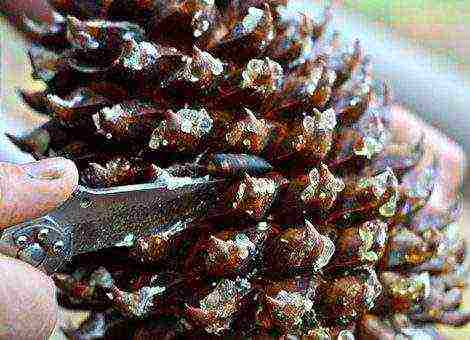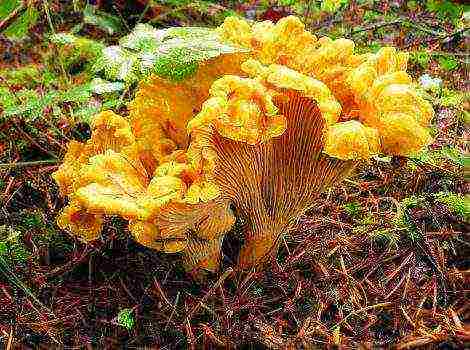Content [show]
The coffee tree has special decorative properties and can decorate any interior, be it a home or an office. But the coffee tree can bear fruit, delighting with aromatic white flowers and red fruits. How to grow a coffee tree correctly: home care, diseases and possible problems will be discussed in detail in this article. You can't get a big harvest from a home-grown tree, but you will be able to enjoy a cup or two of homemade coffee.
In an industrial setting, coffee trees bear fruit throughout the year. The height of trees usually does not exceed 2 m, at home - 1.5 m. The specificity of coffee trees is that their branches are arranged in tiers and do not branch too well. Leaves are slightly wavy, dark green, glossy. Attractive appearance is one of the advantages of the coffee tree, which allows you to grow a crop, if only for the sake of spectacular greenery. Coffee blooms with small white or cream flowers, collected in inflorescences. Often, fruits are tied on the branches of a tree at the same time, fully ripe berries turn red, and flowering occurs. From a home tree, it is possible to collect no more than a glass of grains in a year. But amateur flower growers value the plant not for this, but for the opportunity to enjoy the exotic beauty of the coffee tree at home.
Caring for the coffee tree
The plant is difficult to propagate by cuttings, although this method is quite common. The best results are obtained by seed reproduction. The coffee tree has a powerful root system, so a pot of the required depth is taken for planting. If you take fruits for planting, then you need to remove the pulp, rinse the seeds in a weak solution of potassium permanganate and dry slightly. A mixture of sod and leafy soil with the addition of sand is taken as a substrate. The prepared seeds are planted in holes 1 cm deep, well moistened and covered with foil. Seeds germinate best at 23-25 ° C. Twice a week, the seed pot is ventilated, if necessary, sprayed with a spray bottle. After a month and a half, seedlings usually appear. The pot is placed in a bright place and the film is removed. When forming 2 pairs of leaves, the seedlings are placed in separate pots. During the season, they will have to be transplanted a couple more times, and future trees will begin to bear fruit no earlier than the third year. Today you can buy an adult tree in the store, ready to bear fruit. This option is convenient if it is difficult to get the seeds. In addition, only fresh seeds are suitable for planting, so it is better to purchase a ready-made coffee seedling for growing at home.
The maximum yield can be achieved no earlier than 6-7 years. The plant feels comfortable at home and can please the eye for decades with proper care.In general, caring for a coffee tree at home is not difficult, diseases and pests are not too disturbing, and coffee is not famous for its special whims. True, not every variety is suitable for growing. Arabian coffee and the dwarf variety Nana grow best in indoor conditions.
The tree will begin to bear fruit earlier if it is possible to root the cutting, but this is not easy to do. Even if the shoot is treated with a root-stimulating agent, the rooting percentage will still be low.
The plant cannot be called whimsical, and it is easier to grow coffee than the same citrus fruits and any other exotics. A coffee tree needs good lighting, moderate humidity, and a stable temperature regime. The coffee tree feels great at a temperature of 18-25 ° C. It does not tolerate drought and stagnant water. He does not like drafts and instantly reacts to them with the loss of leaves. The plant also does not tolerate direct sun, but it will feel bad in the shade. From March to October, the plant is fed with organic or complex fertilizers. It is good to feed the tree with formulations without calcium or with its low content.
With increased dryness, the leaves of the plant begin to wither and curl. Dropped foliage also indicates the need for watering. The coffee tree responds well to spraying from a spray bottle. This procedure will not only be useful for the crown, but will also give the greenery shine, brightness and attractiveness.
To grow a healthy and strong coffee tree, follow these guidelines:
- annually in the spring, remove dry shoots and excess twigs that impede air exchange;
- replanting an adult tree is necessary every three years;
- loosen the top layer of the soil, avoiding the appearance of a crust;
- fertilize regularly during the active growing season.
Avoid changing the location of the pot too often, although gradual rotation of the container in which the coffee is growing will help to form an even and beautiful crown. In general, the plant prefers mild and stable conditions. The fewer temperature changes the plant experiences, the better. In winter, it is advisable to lower the room temperature to 18 ° C; if there is a lack of lighting in the cold season, the plant will have to be illuminated. It is highly undesirable to keep coffee near the central heating radiator. The plant does not tolerate dry air and can completely lose foliage. Unlike deciduous flora, coffee grows greens rather poorly, therefore, at the first signs of wilting of leaves, it is necessary to increase the humidity of the air and place the plant away from heating devices.
Exotic lovers know how hard the winter period is for green pets. Exotic plants do not tolerate a lack of light, cold and dry air. Therefore, it is necessary to do everything possible to reduce the negative influence of these factors on plants and create favorable conditions for them for wintering. Since the coffee tree does not have a pronounced dormant period, in winter they simply try to water them less in order to prevent waterlogging of the soil, and stop feeding. In all other respects, plant care remains the same as in the summer.
Problems with growing coffee
We looked at basic home care for a coffee tree, learn about diseases and possible pests. The plant is resistant to pests and rarely bothers flower growers with diseases. However, with increased dry air, the coffee tree can attack the scabbard. With severe infestation, it leads to a complete loss of leaves. At the initial stage, the leaves lose their shine and may turn yellow. This usually happens in winter, when the plant is near heating appliances. It is necessary to treat the coffee tree with Actellic or other preparations of a similar effect and increase the humidity of the air.
Low air humidity also causes spider mite infestations.If you find thin cobwebs on the crown and in the foliage, you should rinse the plant from a spray bottle or under the shower, after covering the soil with a film. Special treatment is usually not required. If you increase the humidity, the problem will quickly disappear. In case of severe damage, the foliage is treated with soapy water.
Over-watering can lead to root rot. To prevent this from happening, it is necessary to alternate root watering with spraying from a spray bottle.
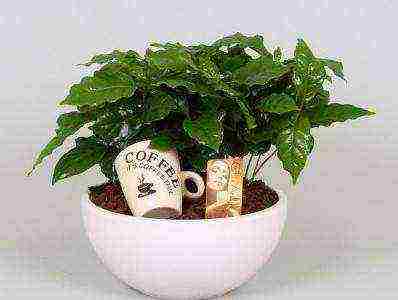 When it comes to such a plant as coffee, the lines of an unpretentious song immediately come to mind - "I'll pour myself a cup of refreshing coffee ..."
When it comes to such a plant as coffee, the lines of an unpretentious song immediately come to mind - "I'll pour myself a cup of refreshing coffee ..."
Thinking it is not realistic to grow a handful of coffee beans for a cup of coffee? Fully possible and not even difficult at all.
The coffee tree is very beautiful in any condition. When it blooms, its aroma will not leave anyone indifferent, when there are no flowers - the plant is decorated with green, glossy, wavy leaves.
…
How to choose the right seedling?
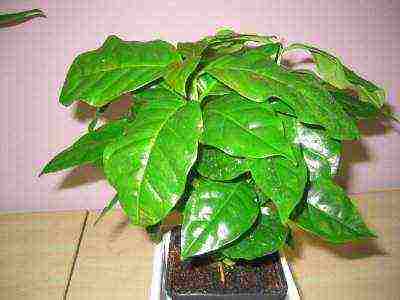 Where to begin? The most real thing is a trip to the store. You will be offered a great variety of copies. Do not hurry. The choice and purchase of a coffee seedling is a responsible business.
Where to begin? The most real thing is a trip to the store. You will be offered a great variety of copies. Do not hurry. The choice and purchase of a coffee seedling is a responsible business.
- Take a good look at the appearance of the plant:
- the color of the leaves should be bright green, without damage or spots;
- there should be a lot of leaves on the plant;
- no signs of disease and insects.
- Read the label with the variety name carefully:
- C.arabica - a real coffee tree, and it is grown as an indoor plant;
- nana - smaller, but more willing to bloom. More decorative.
- For transportation in cold weather or windy weather, pack the seedling well so as not to damage it on the way home.
Plant care after purchase
The coffee tree requires special care at home, but it is not very susceptible to disease. At home, do not put the plant right next to your flowers. Arrange a small quarantine for him, observe his condition for several days. Think carefully about where you will place your coffee for permanent residence. This is not an idle question.
Important! Coffee does not like when it is rearranged from place to place. Even turning around its axis is not recommended.
Mostly coffee is grown in the tropics. And we know that there is warm and humid air. Therefore, in the room where coffee grows, the temperature should be stable all year round, 18 - 20 degrees. Do not put the plant on the window if your winters are cold. This will cool the earthy coma and the plant may die.
Another reason not to put the coffee tree houseplant on the windowsill is the size of the plant itself. Over time it will grow and will reach one and a half meters in height. The crown of the coffee is sprawling. No windowsill is suitable for such a plant.
Also, for the good growth of your pet, you will need constantly spray with water. Better if this is a place near the east or west window.
Flowering and fruiting
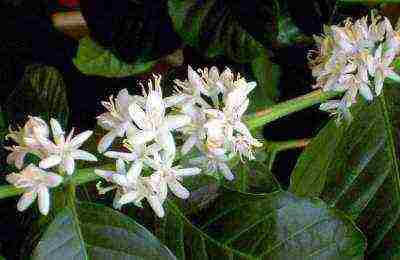 If you organize the right care of the plant, it will thank you with flowers. Coffee blooms in small flowers. Flowers smell very delicate, graceful aroma.
If you organize the right care of the plant, it will thank you with flowers. Coffee blooms in small flowers. Flowers smell very delicate, graceful aroma.
Many lovers, having smelled this aroma for the first time, acquire coffee seedlings thanks to the scent of flowers.
Coffee tree at home blooms annually, sometimes it can bloom twice a year. In spring and autumn.
Why doesn't the coffee tree bloom at home?
The flowering of coffee depends on how the plant is grown. If from a seed, flowering will have to wait for several years (4-5 years), if your seedling has grown from a cuttings of an already mature plant, it can bloom next year. If the coffee has not bloomed in due time, look for mistakes in the care.
No artificial pollination is required. There is an ovary on almost every flower. The ovary looks like a small green pea. As it grows, the fruit turns red, and then takes on a maroon color. Fruits ripen for a very long time, within 9 months.
Transfer
How to transplant a coffee tree at home?
While the plant is small and gaining strength, it will have to be transplanted almost every year in the spring. As you grow older and increase in volume the transplant can be carried out no more than once every three years, but annually change the top layer of the earth to a more fertile one.
It is best to use ready-made soil mixture for transplanting. If this is not possible, you can cook it yourself. We take garden soil - 3 parts, humus - 1 part, peat - 1-2 parts, sand (preferably river) - 1 part. Experts advise adding a small amount of wood ash. Do not forget the drainage, which should be at least 1/5 of the pot.
Important! The soil must be disinfected.
Reproduction at home
 How to propagate a coffee tree at home?
How to propagate a coffee tree at home?
There are two types of breeding the coffee tree at home.
- Seeds. This type of breeding is considered to be very laborious. Coffee seeds lose their germination very quickly and must be planted as soon as possible. The quality of seeds and their germination capacity cannot be checked before planting. Coffee seeds are in a very hard and tough shell that must be destroyed. The seeds must be soaked in a growth promoter.
The treated seeds are grown at high temperatures in a container with loose soil, which is best covered with glass. After a couple of months, the seed should sprout.
- Cuttings. It is believed that this method is easier. Choose a healthy, non-flowering shoot. The prepared stalk must also be kept in a growth stimulator. It is better to root the cutting in the sand. You can make a small greenhouse. A seedling grown in this way will begin to bloom and bear fruit earlier.
Care rules
How to care for a coffee tree at home?
For some reason, it is believed that growing a coffee tree at home is very difficult. Most often this comes from ignorance of the basic rules for caring for this plant.
Caring for a coffee tree at home is easy if you remember the basic rules.
- Temperature. A fairly high and, if possible, constant temperature is required throughout the year. In winter, when the temperature outside reaches minus marks, it is important to avoid cold drafts and try to avoid cooling the flower pot.
Do not place the plant near heating sources. If the floor on which the flower stands is cold, it is better to place the coffee tree on a stand or bedside table. Overheating should not be allowed in the summer.
- Fertilizer.
How to feed a coffee tree at home? Fertilizer for a coffee tree must be added complex, you can also use organic. When preparing solutions, be sure to follow the instructions so as not to harm the plant. Top dressing should be started in spring and finished in autumn. - Lighting. Bright, diffused. Avoid direct sunlight, there may be sunburn. Shade the plant on hot days. In winter, if necessary, arrange additional artificial lighting.
The coffee tree is very beautiful in any condition. In order for the flower to always be attractive, you need to take care of it. Wash and wipe the leaves, systematically loosen the soil. Keep the flower pot clean. Remove yellowed leaves in a timely manner, form a crown if necessary.
You can learn more about how to care for a coffee tree at home in the video below:
How does a coffee tree grow?
Coffee grows at home quickly, you won't even notice how it turns from a small seedling into a beautiful slender tree in a few years.
Photo
The photo below shows a coffee tree at home:
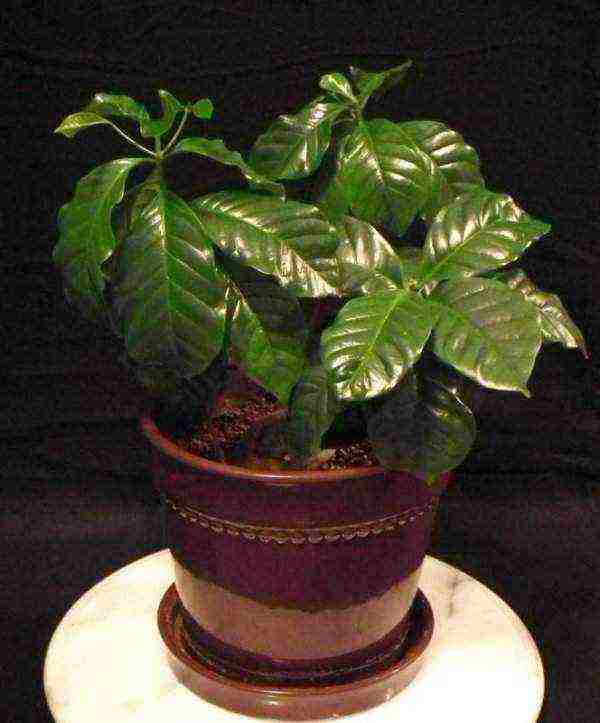
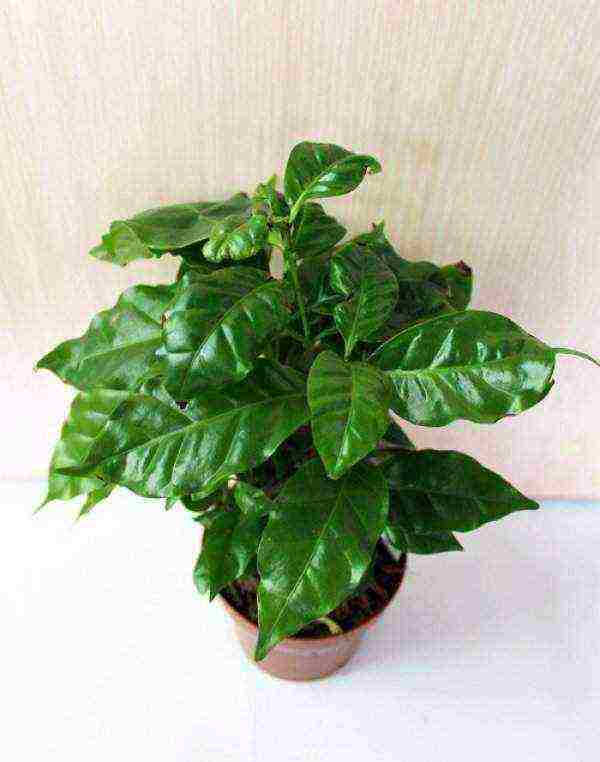
See further in the photo how the coffee tree blooms: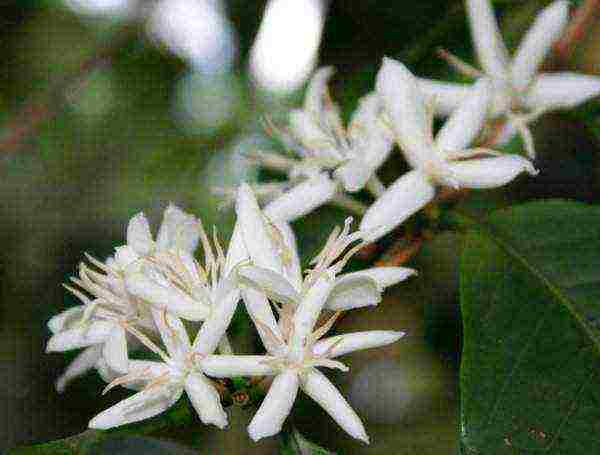

See further in the photo how the coffee tree grows:
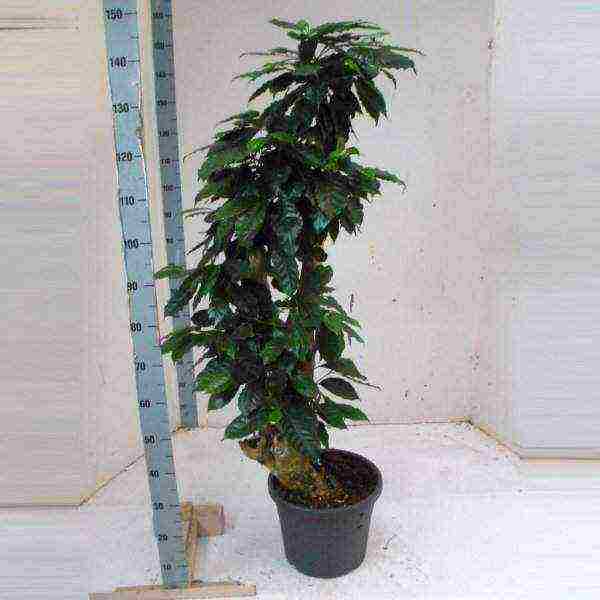
The benefits and harms of coffee
Coffee is a wonderful, invigorating drink. It is wonderful to wake up in the morning and feel its enchanting aroma.
What is the harm from coffee?
The debate about what is more beneficial or harmful in coffee has been going on since they first learned about it. Some argue that coffee excites, increases muscle tone, stimulates physical activity, clarifies thoughts, and improves mood. And the list goes on and on.
Opponents of coffee claim that it increases blood pressure and cholesterol. However, it has been proven that if you pass the brewed drink through a paper filter or napkin, the coffee becomes safe. A paper filter removes kahweol and kafestol from the drink, substances that increase blood cholesterol levels. Harmful or healthy coffee, everyone decides for himself.
Important! If you decide to brew a cup of coffee from grown beans, remember that it will turn out much stronger, and there will be more caffeine in such a drink.
And as for the coffee tree in your home, then we can safely say that you will only benefit from it.
What is the use of coffee?
The plant cleans the air well, saturates it with oxygen. Its beautiful view cheers you up, and inhaling the scent of flowers you can do aromatherapy.
Diseases and pests
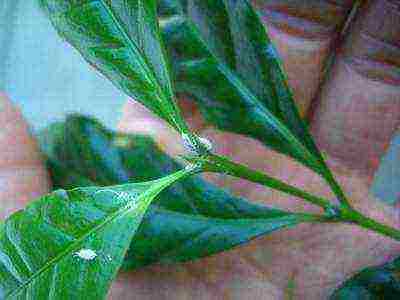 Indoor coffee tree is not susceptible to disease and can only get sick if you bring an infected plant home or use contaminated soil.
Indoor coffee tree is not susceptible to disease and can only get sick if you bring an infected plant home or use contaminated soil.
If your pet's leaves begin to dry, figure it out: this is a disease or mistakes in care.
Perhaps the earth has dried up or, on the contrary, you water your plant too often.
As for pests - with dryness, a spider mite starts up, a scale insect, mealybug, whitefly may appear from other plants. In this case, be patient and take special medications.
To keep your plant happy for as long as possible, remember - prevention is better than cure... You can also add faster and cheaper. Inspect your coffee regularly and act decisively at the first sign of illness or pest infestation.
Important! In indoor conditions, pests affect plants very rarely. If you take your indoor flowers out into the fresh air in the warm season, be prepared for pests to appear on them.
Are you still in doubt? Do not be afraid. You will succeed. Grow a coffee tree, wait for flowering, boil a cup of coffee from the collected fruits, and give others advice on how to care for and grow a coffee tree at home.
Table of contents:
- What does a coffee tree look like?
- Coffee tree care rules
- How to transplant a coffee tree correctly?
- Diseases of the coffee tree: prevention and treatment
- When to wait for the harvest
Most people associate the coffee tree with plantations and greenhouses, but it can grow favorably at home if you create a comfortable environment for it. At the same time, you do not need to spend a lot of time and effort to care for this plant.
What does a coffee tree look like?
The shops sell small plants with glossy dark green leaves that have an elongated and wavy shape. This is the coffee tree. With proper care, it begins to bloom at the age of 3-4 years in the summer, releasing beautiful flowers. They are collected in inflorescences, in the place of which red berries soon appear, they are edible, but the main value is their grains.
An adult tree can produce up to 500 grams per flowering. grains, they need to be further processed, dried well and fried. According to many owners of coffee trees, coffee made from crops grown with their own hands is much tastier than purchased.
Coffee tree care rules
The coffee tree is considered a fairly unpretentious plant, the main thing is to provide the correct lighting and temperature. For the coffee tree, home care should focus on flowering and grains. In this case, it will delight not only with its excellent appearance, but also with the harvest. So, here are the basic rules.
Basic lighting conditions
Providing the correct lighting for the plant is essential to produce flavorful grains. The light should be bright but diffused. In no case should direct sunlight be allowed, especially at noon. An ideal place would be an east, southeast or west window. In order for the plant to receive the necessary portion of light, there should be as much space around it as possible, so other plants should be at a distance of at least 40-50 cm.
Temperature regime
 The coffee tree is a thermophilic plant, so it is extremely difficult to tolerate the cold. In winter, even during severe frosts, the temperature should not drop below 16 degrees, but it is better to maintain it from 18 to 20. Do not forget about the dry air, which is provided by power sources in winter. So that the coffee tree does not suffer, it must be watered with warm water. One of the biggest dangers for this plant is the lack of ventilation. However, there should be no draft during this procedure, otherwise the coffee tree will shed all the leaves.
The coffee tree is a thermophilic plant, so it is extremely difficult to tolerate the cold. In winter, even during severe frosts, the temperature should not drop below 16 degrees, but it is better to maintain it from 18 to 20. Do not forget about the dry air, which is provided by power sources in winter. So that the coffee tree does not suffer, it must be watered with warm water. One of the biggest dangers for this plant is the lack of ventilation. However, there should be no draft during this procedure, otherwise the coffee tree will shed all the leaves.
Watering rules
In order for the plant to develop and bear fruit properly, you need to know how to water the coffee tree. Sometimes the instruction "Home care with a photo" helps to correctly calculate the irrigation schedule in order to prevent overdrying or destructive gulf. The coffee tree has two periods of the year: active and sleep. During the active period (from March to October), the plant requires abundant watering, but it is important to ensure that excess moisture does not accumulate in the soil and sump. The water should be soft, it is advisable to defend it before watering. During the rest period, watering must be reduced and carried out only after the top layer has dried.
Underlining the coffee tree
In the summer, the amount of feeding is increased to once every ten days, any fertilizer without calcium is chosen. The best option is a universal mineral remedy. During the rest period, feeding is not required.
How to transplant a coffee tree correctly?
The plant needs to be transplanted once every 2-3 years, it is better to choose March or April for this.
If the coffee tree has not yet reached maturity, then this procedure is carried out annually. And the most mature plants can not be transplanted, but simply periodically change the topsoil.
The soil should be slightly acidic, heavy, with a lot of humus additives. The owner of the coffee tree can buy a ready-made mixture or make it yourself from turf and leafy soil, sand and clay.
The root system of this plant is powerful and deep. This must be taken into account when choosing a pot. It should be voluminous and tall, with good drainage to avoid stagnant moisture.
Diseases of the coffee tree: prevention and treatment
- The main cause of diseases of this plant at home is improper care. For a coffee tree, home care turns into diseases if stains appear, leaves curl and dry out. It is worth immediately removing the damaged areas of the plant, and then determining the cause of the lesion.
- Fungal disease often occurs due to overflow of soil, roots may have begun to rot. In this case, the first step is to check the roots, all damaged areas are removed with a sharp knife and sprinkled with crushed coal. The plant is then dried and planted in new soil. The upper part is treated with insecticidal soap, copper sulfate or any other ready-made preparation for fungal diseases.
- The most dangerous pest of the coffee tree, which often appears at home, is the whitefly. The plant, which is affected by this pest, is covered with white bloom and cobwebs. As soon as the first signs are found, measures must be taken, otherwise the whitefly can lead to the death of the coffee tree.To get rid of the pest, the leaves are sprayed with soapy water for two weeks; in case of serious damage, each leaf is wiped.
- Whitefly is not the only pest, the owner of the coffee tree should be prepared for the appearance of scale insects and powdery mildew. In this case, you will need alcohol, a solution of actellik or karbofos (based on 10 drops of 0.5 liters of water).
When to wait for the harvest
With proper care and prevention of diseases, within 4-6 years after purchasing the plant, it will delight the first harvest. Many people prefer the Arabica coffee tree, home care for this variety is carried out as described above. The grains of this variety are distinguished by their excellent aroma and rich taste. Robusta can also be selected for home cultivation, but the coffee made from its fruits is less aromatic and has a bitter taste.
Find out which flowers should not be kept at home: take care of your health. How to care for ficus, read this article / Lush and beautiful plant in your home
Despite the doubts of many home plant lovers, the coffee tree is one of the most unpretentious and grateful. Caring for it does not take much time and effort, and diseases and pests, if they appear, can be quickly eliminated using folk methods or special chemicals that are sold in flower shops.
Already many plants have not learned how to grow our growers at home. From the most common compact flowers to tropical vines. Many people want to try growing something exotic and a coffee tree is ideal for growing at home. The types of this plant are different, but if we decide to grow, then the most suitable would be Arabica coffee and here's why:
- Grows up to 1 meter
- Looks like a bush
- Great for decorative applications
- Has a very pleasant smell
- Unpretentious in care
One of the main advantages of the coffee tree is that you do not have to spend a lot of time caring for it, because Arabica is one of the most unpretentious plants. In our conditions, it is best to grow a tree from grain or cuttings. Then the coffee tree will best adapt to our habitat!
What types of coffee are advisable to grow at home, and where does real coffee grow?
In home gardening, only a few varieties of coffee trees are grown, among them Arabica coffee is especially popular. In its natural habitat, the coffee tree belongs to the madder family, which has more than 5 thousand species.
Of all the species, only 60 belong to coffee trees. Their distribution looks something like this: most of them grow in Africa, then Madagascar, Southeast Asia boasts ten types, and only 3 types of coffee grow on the island of Mauritius. Coffee trees found their second home in Brazil.
Coffee trees are very diverse, among their representatives in wildlife there are evergreens and shrubs, trees and tall varieties. All varieties of coffee trees are united by such a trait as the presence of a large dose of caffeine in the leaves and beans.
Massive coffee trees can grow only in equatorial countries, but it is difficult for them in hot tropical climates. For this reason, the plants are planted above 1.2 thousand meters above the sea.
Massive coffee trees can grow only in equatorial countries, but it is difficult for them in hot tropical climates. For this reason, the plants are planted above 1.2 thousand meters above the sea.
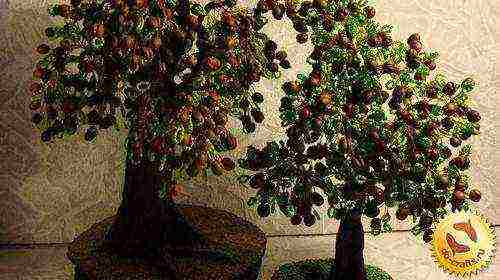
From the point of view of benefits, only a few types of coffee plants are important: Arabica coffee (the second name is Arabian) and Robusta. Useful crops can be Liberian and high coffee.
Arabian coffee
popular in home cultivation, represents a compact tree.The leaves are shaped like an elongated ellipse with a dark olive tint, glossy on the outside and pale on the inside. The inflorescences are small, about 2 centimeters in diameter, collected in a bunch. The size of the inflorescences directly depends on the growing conditions.
After opening, flowers are fresh for only a few hours. But the buds open gradually, not at once. After the inflorescences have faded, the fruit ripens in the form of a berry, in ripe form it has a burgundy hue. Maturation occurs approximately 8 months after pollination. The paired fruits resemble round beans. This species reaches a height of up to 5 meters.

Dwarf coffee Nana
it is a neat plant, reaching a height of about 85 cm. The flowering is abundant and subsequently bears fruit well at home. The desired design can be given to the tree by cutting and pinching the tops of the plant.

Liberian coffee
also grown indoors. Its ripe fruits have a scarlet or sunny slightly orange hue. The length of its leaves reaches up to 40 cm, and the height is regulated and the required shape is formed by trimming the crown of the plant. The inflorescence has a light shade and large fruits - berries.
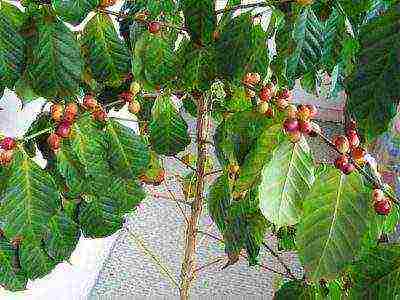
Growing a coffee tree from a grain
To do this, you need ordinary coffee beans, which can be purchased in the store (only, of course, not roasted), or beans taken directly from the plant itself (suddenly your relatives or neighbors are happy owners of it). The cultivation method is almost the same as, for example, pomegranate or lemon - there are only a few characteristic features.

Since the shell of a coffee bean is very tough, hard and often interferes with the germination of the seed, it is necessary to carry out the so-called scarification before planting. This is the destruction of the shell by a chemical method (solution of hydrochloric or sulfuric acid), or mechanically - the grain must be cut or sawed.
The next step is to soak the grain in a stimulant solution. Well suited "Epin", "Kornevin", "Zircon" or others. It is imperative to plant the seed in soft, loose soil. The pot with the planted seed must be placed in a sunny place so that it germinates as soon as possible, the temperature must be at least 20 degrees.
- Seeds are cleaned of pulp and washed in a solution of potassium permanganate.
- The land for planting the seeds should be prepared ahead of time, two weeks in advance. The substrate must be mixed and left to "reach". The mixture includes well-steamed turf soil with sand and peat. Ash can be added.
- The seeds are placed on the ground with the flat side down, slightly pressed and buried by 1 cm. Everything should be well shed and covered with a transparent cover (glass, film).
- The container with the sown seeds is placed in a bright place, sheltered from the direct sun, the substrate humidity is kept constant and the ambient temperature is about 25 °. Ventilate daily.
- If the conditions are met, the seeds will hatch in a month.
- The appearance of the first pair of leaves can be the signal for the first transplant. Pots are chosen small, but deep, no more than 7 cm in diameter. You should carefully cover the seedlings from the sun.
- At the beginning of the lignification of the trunk, it may seem that it is drying out and cracking. In fact, the process is going well. A brown color, spotting of the trunk may appear, but soon it takes on its usual appearance.
- Make the next transplant in a month, slightly increasing the capacity.
Growing a coffee tree from a cutting
If you find where to buy a stalk of a coffee tree, then it is better to use this planting method. A tree planted in this way will grow faster, and, therefore, yield faster. The second advantage of this planting method is that the tree will grow in width, not in height, as when planting a seed.Planting a stem of a coffee tree is very simple, there are no differences from other cuttings.

This method has its advantages:
- If all conditions are met, 100% rooting is achieved;
- All characteristics of the mother plant are preserved;
- Flowering may occur in the first year;
- Fruiting begins 2-3 years earlier than plants grown from seed;
- The fruits are more numerous and larger.
Caring for the coffee tree at home
How to properly land was described above. How to properly care for a coffee tree? Many amateur flower growers, who do not have sufficient personal experience in caring for indoor plants in general, not to mention a coffee tree in particular, draw information from very dubious sources. The consequences of this are very disappointing - people spend incredible efforts, funds, fuss around it, they are almost afraid to breathe near the plant - and the sense from this, at best, is zero.
All this happens because not everyone knows that caring for this seemingly fastidious tree is very, very simple, you just need to adhere to simple rules.
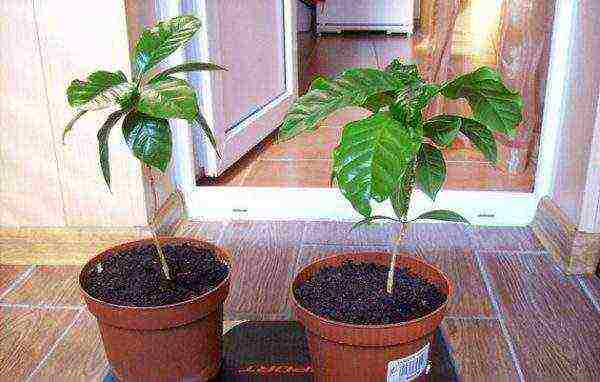
Landing
The very first step on the road to a luxurious and fruitful coffee tree in your garden is of great importance - planting, and, in some cases, replanting the plant. The most basic thing to remember is that the coffee tree grows exclusively in an acidic environment (that is, ph should be equal to

